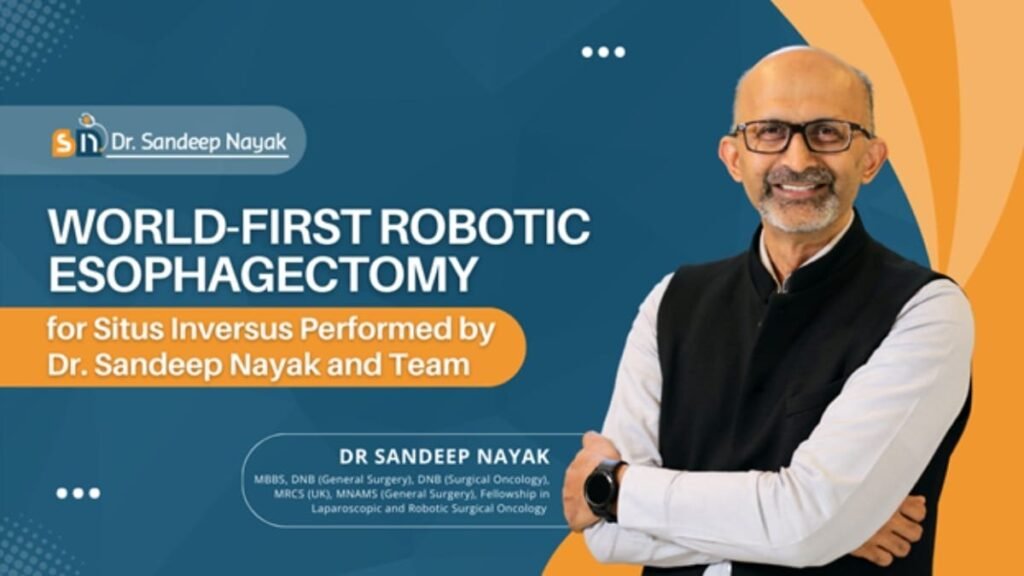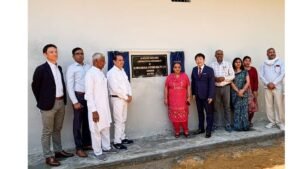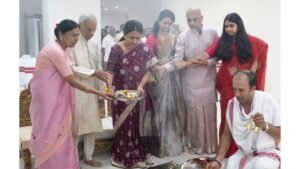Dr Sandeep Nayak Performs World First Robotic Esophagectomy on Patient with Situs Inversus

Bangalore (Karnataka) [India], April 30: Dr. Sandeep Nayak has successfully performed the world’s first robotic transthoracic esophagectomy (TTE) on a 62-year-old woman with oesophageal cancer and situs inversus totalis. This successful robotic surgery renews hope for patients with rare medical conditions.
Situs inversus totalis is a rare congenital condition detected in less than 0.01% of the population. In this condition, the major internal organs in the chest and abdomen are positioned in a mirror-image reversal of normal anatomy.
Dr. Sandeep Nayak, a leading surgical oncologist in India, shares key insights into the procedure and its associated complexities. “This case was one of the most technically challenging surgeries we’ve performed. Situs inversus requires the surgeon to rethink and reverse every step of the operation. While robotic technology helped make the surgery minimally invasive for the patient, the complexity of the reversed anatomy demanded meticulous planning and execution. This success highlights what is possible with the optimal combination of advanced technology, expertise and teamwork.”
Navigating a Rare and Complex Challenge
Earlier this year, Dr. Sandeep Nayak had the opportunity to perform this procedure on a 62-year-old woman with esophageal cancer and Situs Inversus Totalis who had approached him for treatment. According to global medical records, the first laparoscopic case was in 2016 and a robotic trans-hiatal approach in 2022; hence, this is the first-ever reported instance of a robotic transthoracic esophagectomy in such a complex medical condition.
According to her stage of cancer, she had to undergo crucial chemo-radiation therapy administered by Dr. Nisha Vishnu and Dr. Suresh Babu, preparing her for the complex surgical procedure. In January 2025, Dr. Sandeep Nayak and his multidisciplinary team performed Robotic Transthoracic Esophagectomy (TTE) and lymph node removal. In February, she underwent a minor procedure to improve the swallowing ability and is recovering well under the supervision of the medical team.
Situs Inversus is a rare congenital condition where the major internal organs are mirrored or reversed from their normal positions. Though individuals with Situs Inversus live healthy lives without complications but when some condition requires surgery it becomes challenging.
Surgeons attempting resolve this condition must be very much aware of the situs inversus with the capability to undertake accurate diagnosis and proper planning of the surgical procedures. Extensive pre-operative efforts include imaging, CT Scans and MRIs to get a fair overview of the patient’s reversed anatomy state. Hence, during the surgery, they have to adopt a “mirror-image” approach and make necessary adjustments when using the surgical instruments and executing the standard techniques.
It is necessary to have in place a team of expert surgeons who are well versed with in advanced medical technology along with their surgical precision to have the best possible outcomes in such patients, while keeping in mind the highest degree of patient safety. Referring to this case, Dr Sandeep Nayak shares his experience stating, ‘Although minimally invasive in approach, robotic surgery, with magnified visualization and precision provided invaluable insights, direction and pathways when operating within a highly complex surgical landscape ensuring a successful procedure.
A Milestone in Cancer Surgery
As aptly observed the unique demands of the surgery, Dr. Sandeep Nayak, states, “This case stands out as one of the most technically demanding surgeries we have undertaken. Situs inversus compels the surgeon to fundamentally rethink and reverse the entire operational sequence. While the robotic technology was instrumental in achieving a minimally invasive outcome for the patient, the inherent complexity of the reversed anatomy demanded meticulous planning, unwavering focus, and seamless teamwork. This successful outcome underscores the remarkable potential when cutting-edge technology converges with specialized expertise and collaborative spirit.”
Bangalore-based Dr. Sandeep Nayak who led the surgery, is expressed great satisfaction about this achievement. It highlights a high level of awareness about and increasing knowledge in minimally invasive esophagectomy for rare conditions. This feat represents the world’s first surgery in resolving Situs inversus conditions and also paves the path for treating similar patients with intricate anatomical variations. This surgery is a landmark in itself as it highlights the important interdisciplinary collaboration and innovation in treating life-threatening diseases such as cancer.
Patient-Focused Innovation
Dr. Sandeep Nayak, a proponent of robotic surgery, adds that this surgery highlights the scope of dedicated surgeons and medical professionals in attempting to resolve the most challenging of medical cases through minimal access surgical options, which implies speedy recovery, fewer surgical complications and trauma in comparison with traditional open surgery.
Dr. Sandeep Nayak urges patients with similar medical complexities to can come forward to resolve their conditions through advanced surgical techniques, especially minimally invasive techniques and recover well and improve their quality of life. Armed with expert surgical skills and advanced surgical technologies, committed and dedicated surgeons can take on the most challenging medical cases.
If you have any objection to this press release content, kindly contact pr.error.rectification@gmail.com to notify us. We will respond and rectify the situation in the next 24 hours.







